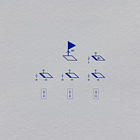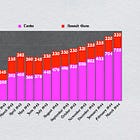With an authorized strength of one officer, five non-commissioned offices, and fifty-five men, a grenadier escort platoon [Grenadier-Begleitzug] consisted of a platoon leader, a three-man reconnaissance team, a two-man supply element, and eleven escort teams [Begleittrupps].
One of the escort teams rode with the platoon leader on the assault gun of the commanding officer of an assault gun company. One served as a spare team. (As such, it was only assigned to an assault gun when there were more than ten assault guns in the supported assault gun unit.) The nine remaining teams consisted of three escort squads, each of which worked closely with a three-vehicle assault gun platoon.
Each escort team consisted of a leader, a combat engineer, and three riflemen. In each squad, the senior team leader, who ranked as a non-commissioned officer, also served as the squad leader. (As such, he normally rode on the vehicle of the leader of the affiliated assault gun platoon.)
According to the Army High Command, which mandated the raising of such units, grenadier escort platoons served to enhance the Stoßkraft, Einsatzfreudigkeit and Angriffsfreudigkeit of assault gun units. (Stoßkraft might be translated as “thrusting power,” Einsatzfreudigkeit and Angriffsfreudigkeit as “enthusiasm for action” and “eagerness to attack.”)
Grenadier escort platoons fulfilled this mission by:
remaining close to the assault guns to which they were assigned in all phases of an attack
providing covering fire as assault guns work their way forward
protecting assault guns from close-combat teams [Nähkampftrupps]
warning the commanders of assault guns and assault gun units of such things as camouflaged anti-tank guns, minefields, obstacles, and low-flying aircraft
indicating the presence of suddenly appearing tanks by shouting and by shooting at them
guiding assault guns through difficult terrain (such as ground covered by swamps, trenches, or shell holes)
guarding assault guns that have been immobilized
Fifty-eight members of an escort platoon, including the platoon leader and all of the non-commissioned officers wielded assault rifles. Three, the two supply specialists who drove the company truck and the man who drove the motorcycle of the reconnaissance team, carried bolt-action rifles.
Also known as the “special purpose” [zur besondere Verwendung] team, the reconnaissance team provided the leader of the grenadier escort platoon with the ability to range ahead of an assault gun unit, thereby locating both dangers and opportunities.
In cases where a division lacked the resources to provide assault rifles to all members of its escort teams, some grenadiers would have to make do with bolt-action rifles. If, however, this substitution resulted in a platoon in which more than half of the men wielded bolt-action rifles, the division was obliged to provide each escort squad with a light machine gun.
In cases where a division proved unable to fill all twelve billets with fully-fledged combat engineers, it was permitted to fill as many as seven of those positions with infantrymen who had been trained to use mine detectors and handle explosive charges. However, under no circumstances was a division to let the number of proper pioneers in a grenadier escort platoon to fall below five.
On 20 October 1944, the Army High Command mandated that each infantry division that possessed either assault guns or self-propelled anti-tank guns form a grenadier escort platoon “out of hide” [auf dem Kommandoweg]. That is, the authority that required divisions to organize grenadier escort platoons provided neither the men nor the machines needed to create them. Similarly, while the Army High Command provided a fourteen day training syllabus for newly raised grenadier escort platoons, it charged individual divisions with the responsibility for executing that program of instruction.
The Army High Command instructed divisions to assign their best “individual fighters” [Einzelkämpfer] to the grenadier escort platoons, to refrain from returning such men to infantry units of other sorts, and to ensure that the paybook of each member of an escort platoon be marked with the words “not to be assigned to units other than grenadier escort platoons.”
Source: This post paraphrases portions of a letter of instruction issued by the Army High Command on 20 October 1944. I found the letter in the records of the Organization Department [Organizations-Abteilung] of the Army General Staff [Generalstab des Heeres], US National Archives, Microfilm Series T-78, Roll 526, Frames 660-668.
For Further Reading:
.











